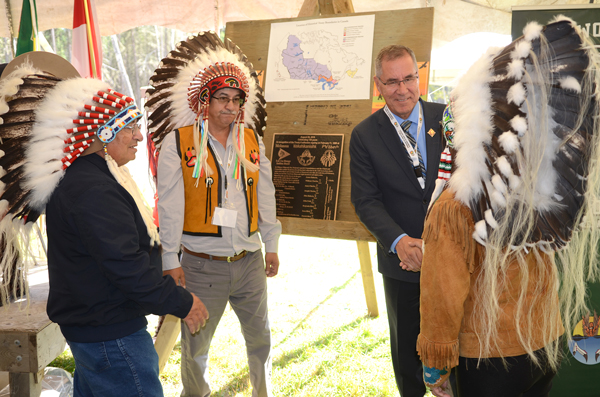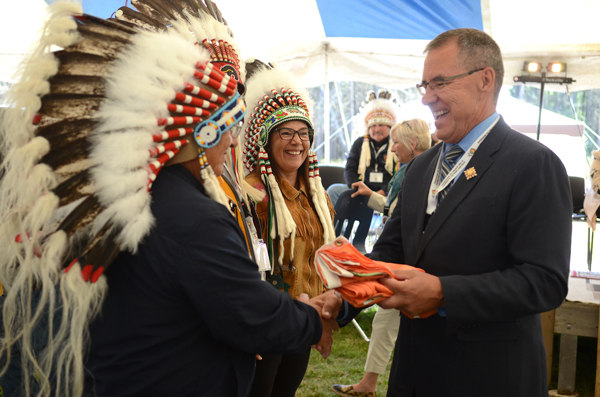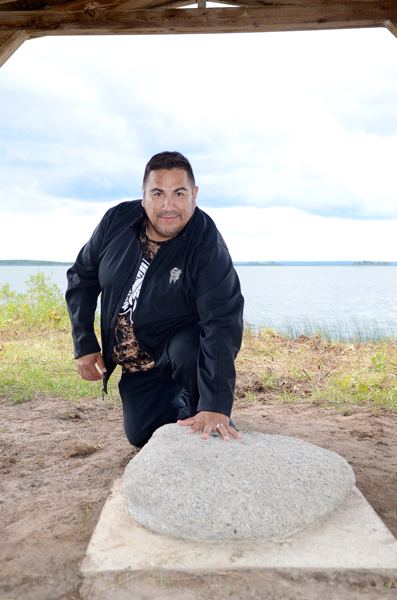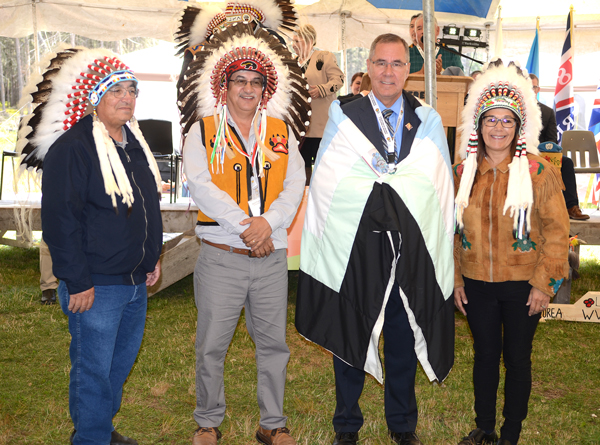
One hundred and thirty years ago Chiefs William Charles and James Roberts, along with their headmen, met with commissioners A.G. Irvine and R. Goulet along the east shore of Montreal River, near a place called Molanosa, about 70 km south of La Ronge.
The chiefs of the Woodland Cree were facing low fur prices and a scarcity of animals for hunting, fishing and trapping.
They knew a treaty had been signed about 13 years prior in Fort Carlton. They wanted education, farming instruction and implements and a medicine chest to help take care of their people.
They were promised that no harm would be done and their people protected, that they would still be able to live off the land and the lake.
They maintained they didn’t give up the water and resources below that of the depth of a plow.
The adhesion to Treaty 6 was signed, and at that spot, a metal stake topped with an emblem was driven into a boulder. It said “IR” — or Indian reserve.
Wednesday, the chiefs of those same groups — now known as Lac La Ronge Indian Band, Peter Ballantyne Cree Nation and Montreal Lake Cree Nation, gathered once again on the riverbank in Molanosa.
Surrounded by residents of all three communities, along with MLAs, government officials and members of the RCMP, Lac La Ronge Indian Band Chief Tammy Cook-Searson, Montreal Lake Cree Nation Chief Frank Roberts, Peter Ballantyne Cree Nation Chief Peter Beatty and Lt.-Gov. Russell Mirasty unveiled a treaty adhesion flag and plaque to commemorate 130 years since the treaty adhesion was signed.

In addition to the flag and plaque unveiled Wednesday, the 130th anniversary will also be marked by a Treaty 6 Adhesion Scholarship Fund, open to post-secondary students from the three communities. A website will also be launched this fall at treaty6adhesion.ca.
According to organizers of Wednesday’s event, researchers have determined that Molanosa is one of only two locations in Canada where the exact spot a treaty was signed is known. The other is in Treaty 4 territory.
Marking that spot with a plaque is “really important,” Cook-Searson said.
“There will be stories about this historic event today. When my grandchildren or great-grandchildren come to look at it, they’ll have something written there.”
Lt.-Gov. Mirasty is a member of the Lac La Ronge Indian Band and a descendant of one of the original signatories to the adhesion agreement.
“It’s an honour to be here. It’s a special day,” Lt.-Gov. Mirasty said.
“It’s a special event to remember the treaties because of what they mean to us as First Nations people from this territory, but also for people in Saskatchewan and Canada.”
He added he was also honoured to be at the event as a representative of the Queen.

“To be here on this ground, to be a part of the commemoration is very special,” he continued. “Our people have always felt the treaties were sacred and really important to us — how we would interact with the people from afar, the newcomers. To be a part of this… to commemorate the significance of the treaties is very meaningful to me.”
According to the event’s emcees, the treaties were promised as long as the sun rose, rivers flowed and grass grew. The promises, they said, were to not do any harm and to protect the Woodland Cree in the end. That, they said, is the spirit and intent of the treaties.
Cook-Searson said progress is being made, but more needs to be done to realize the full spirit and intent of the treaties.
The commemoration is “three (communities) coming together …. To honour our treaty and honour where we came from … thinking about what (our ancestors) wanted for us today,” she said.

“The things they wanted for the generations to come ahead, to think about 130 years and what people have come through and the reconciliation that needs to happen. There is still a lot of work to do but we are very strong people and very resilient.”
Cook-Searson said she was proud to see the lieutenant-governor, a First Nations person from La Ronge in attendance. Many of the RCMP officers, including some of the senior officers in attendance, are also First Nations.
“Times are changing,” she said.
“It’s happening, slowly but surely we just have to keep at it and keep working on reconciliation and building that relationship together.”


